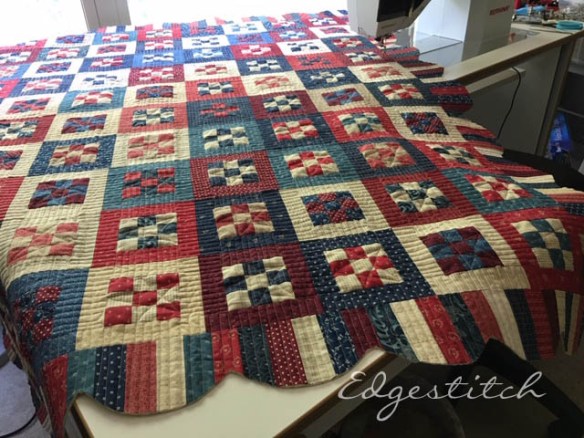
We have all seen the books about making “scrappy” quilts. You may even own a few of them. I know I do. And most of them recommend separating all your fabrics into neat, color-coordinated bins.
Sounds great.
Have you ever tried to do it? I find myself asking questions. What about this colorful print which really does not seem to fit into just one category of color? What about this collection I purchased all at once which coordinates perfectly with the other fabrics from its own collection? Do I really want to wrench those apart? (Hello Downton Abbey fabric line from 6 years ago.) And then there are the pre-cuts. Am I supposed to take apart these charm packs and layer cakes and re-sort each and every fabric into different categories even though they are all from the same collection and look great together?
As you can imagine, my answer was no. In fact, I was feeling a little defiant. Guess what? There are no rules.
Normally when we talk about making a scrappy quilt, we just mean that we are going to make an ordinary quilt from some pattern we’ve purchased, by shopping our stash. I’ve done that many times. Here’s a nice pattern. What do I own that will look good? Most of the time, I can fill out the pattern requirements part of the way. But in the end, I’m missing the exact perfect shade of grunge that I need to finish. Or I just need 5 more fatquarters in this color family. Or I need a better binding or 4 yards of backing. No matter how hard I try using that method, I always end up purchasing more fabric. Which, frankly, is not my goal.
That old saying? She who dies with the most fabric wins? No she doesn’t. She just becomes a pain in the rear end to her family AFTER SHE’S DEAD.
That’s not the legacy I want to leave. Too many quilts? Yes, my family will grapple with that, but at least those are useful.
Anyway, I might be in a dark place because a friend of my sister’s, and a family acquaintance, just suffered a severe health emergency. (not COVID.) But she is middle-aged, and was healthy and vibrant until this struck. And now she’s got a long recovery ahead of her. I’ve had her on my mind so much recently, that I decided to make her a quilt. One that was scrappy but strong…a message I want to convey to her. Lots of pieces put back together in odd ways can make something interesting and strong and vibrant.
So instead, I started with whatever fabric I had been hanging onto for years, moved from bin to bin, never having a purpose. I put them all together in a pile and challenged myself to make a quilt.
And this is the result.

It’s made from a mini charm pack bundle I was given as a sampler at Quilt Market years ago, along with a couple of charm packs, and scraps of red and coral fatquarters. The backing is 4 yards of vibrantly red fabric. I feel like this quilt is saying:
I’m strong.
I’m tough.
I’m fierce.
I break the rules.
Don’t f$%^ with me.
And that’s the message I hope is conveyed to our friend who will receive it. Ride it out. Don’t let anyone tell you that you are weak. Show them you are a survivor. Be bold.
So my challenge to you today is this: If you’re feeling like you’re in a rut, break out. Do the thing you are told you should not do. Put two colors together that don’t belong. Simplify. Complicate. Whatever it takes to shake it up for you. And then pass it on to someone else who really needs the courage.










































